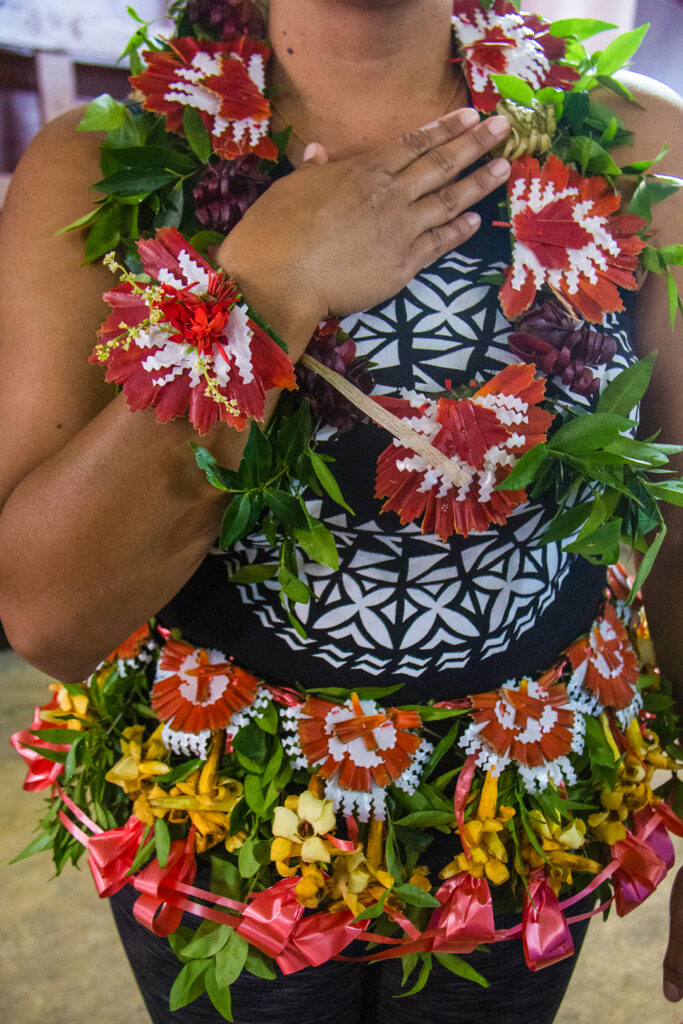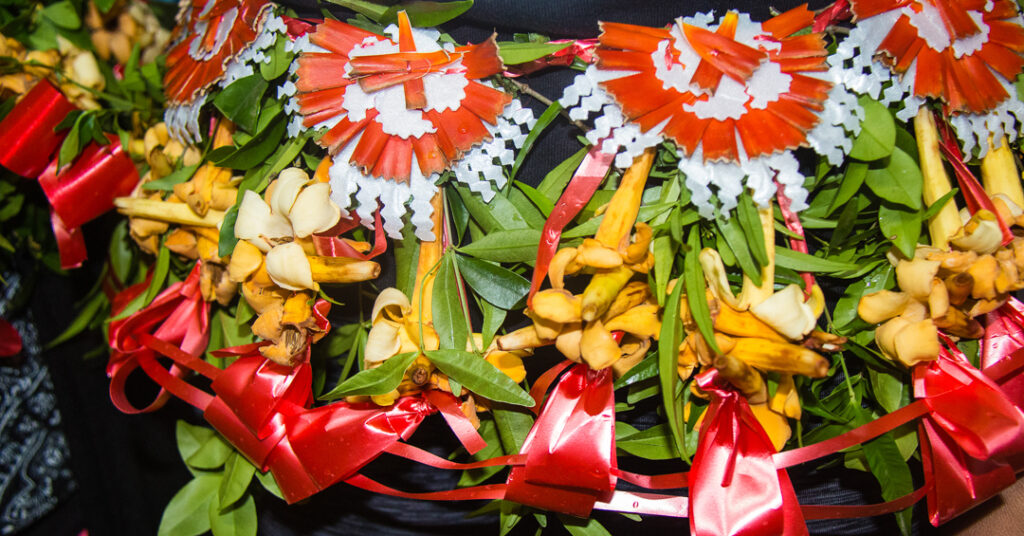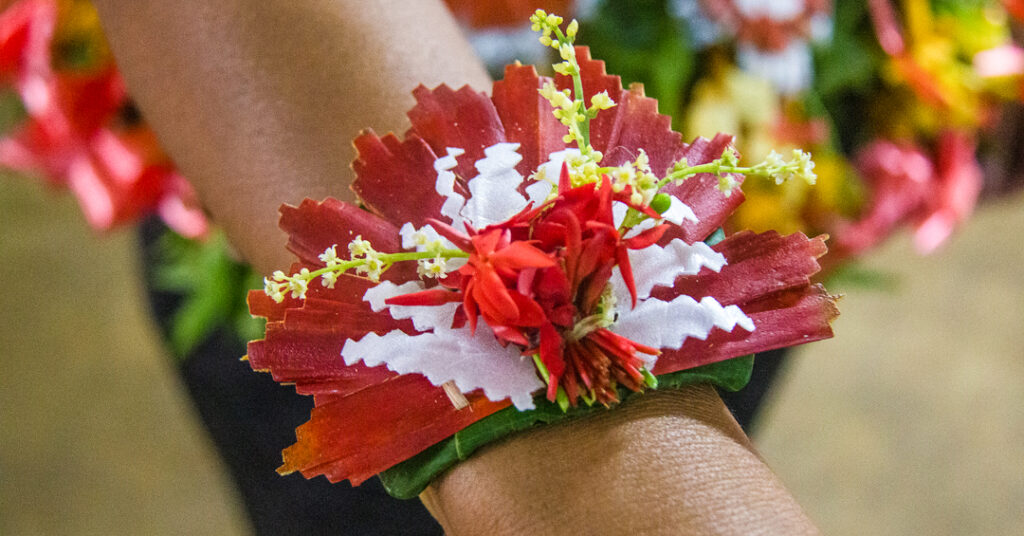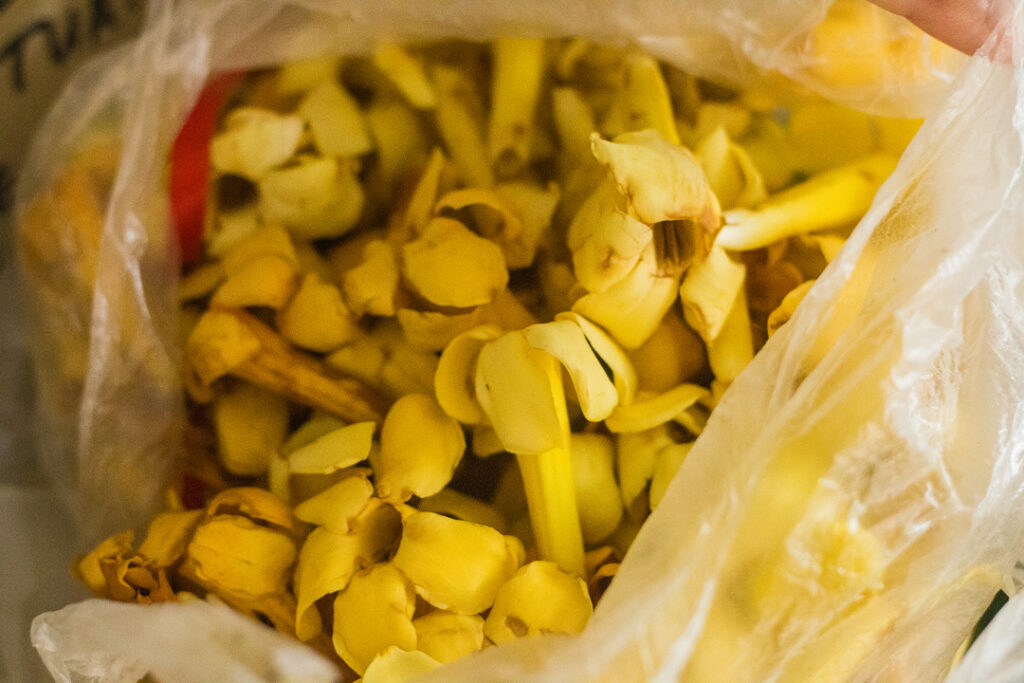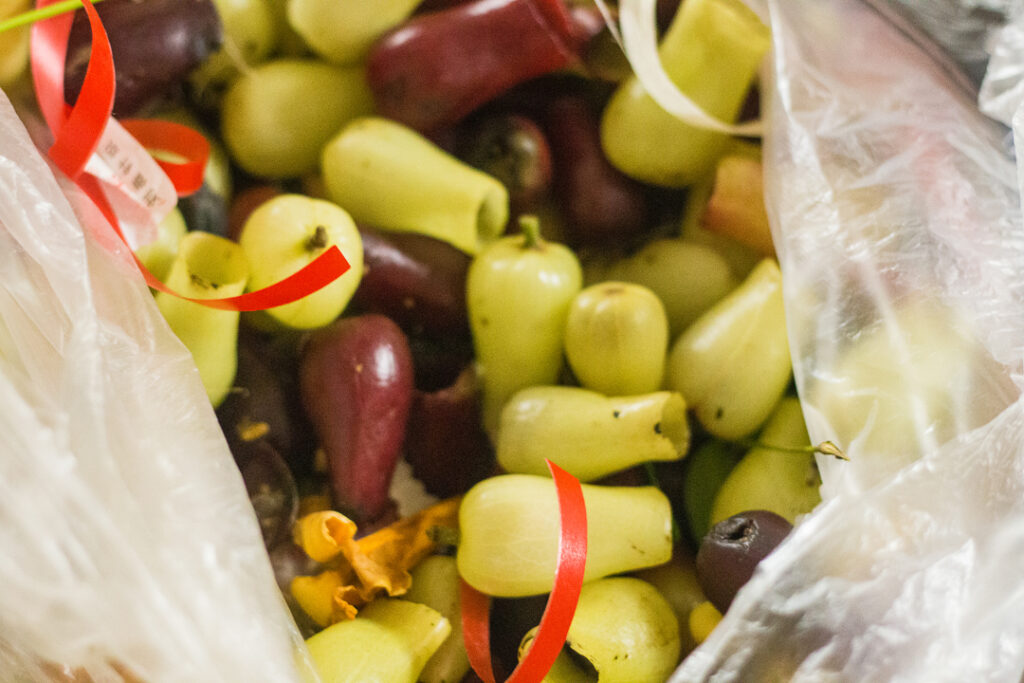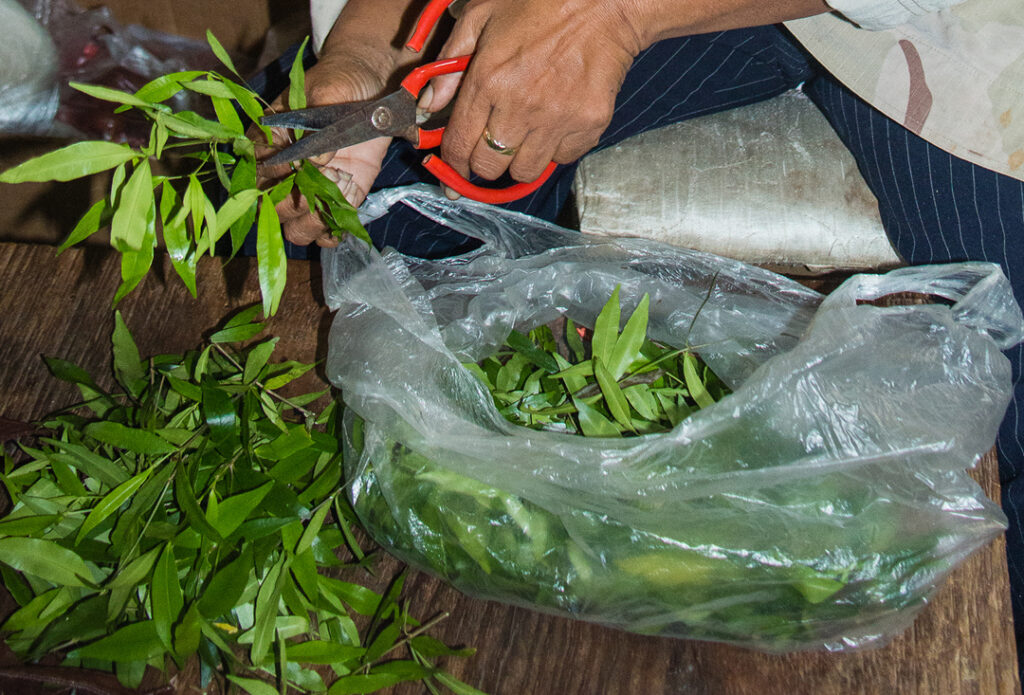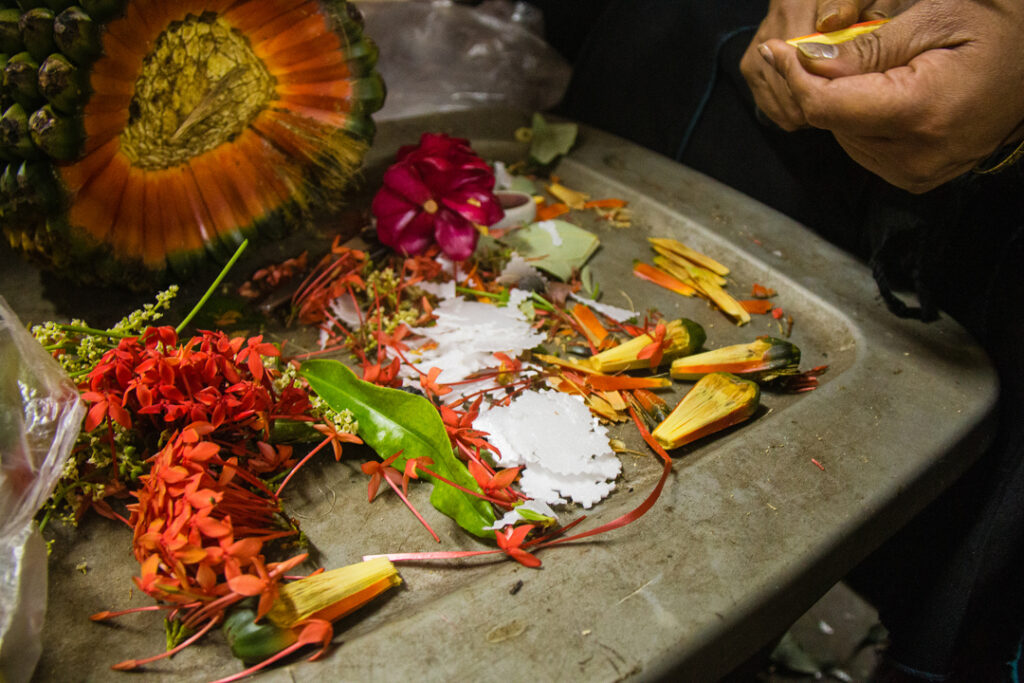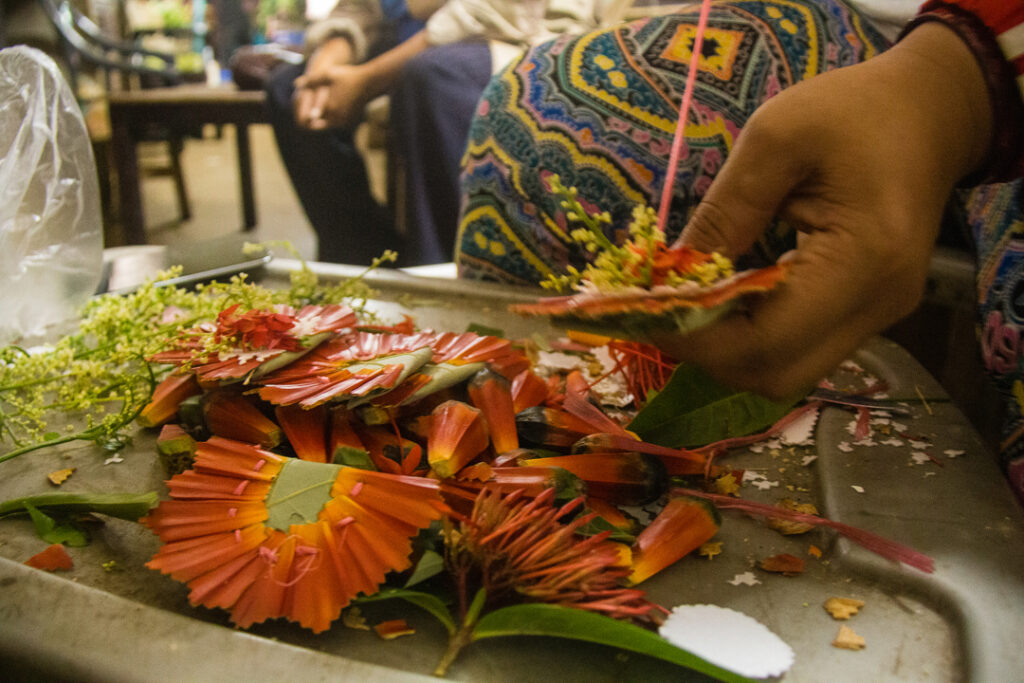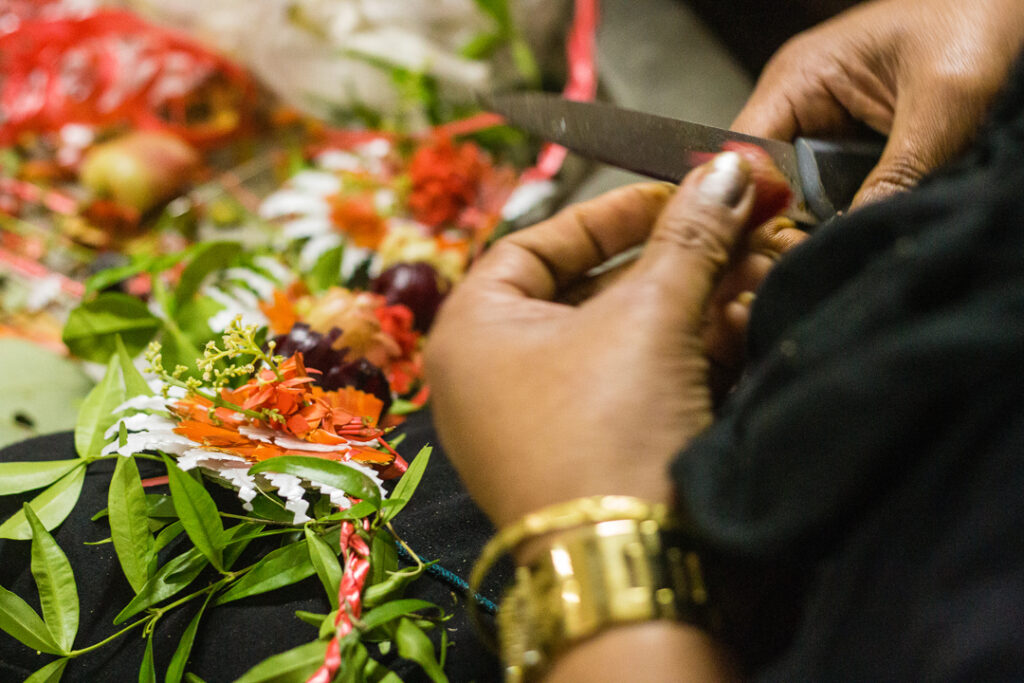
Pandanus fruit (Pandanus tectorius); image taken at Talamahu Markets in Tongatapu, Tonga by Penina Momoiseā for the CoconetTV Measina Pasifika Lei Culture gallery, 2017.
Hūfanga-He-Ako-Moe-Lotu, ‘Ōkusitino Māhina, Kolokesa Uafā Māhina-Tuai and Tavakefai‘ana, Sēmisi Fetokai Kulīha‘apai Moahehengiovava‘ulahi Potauaine share the profound meaning of smell in Tongan culture.
(A message to the reader.)
Fakafe‘iloaki Fiefia & Māfana (Happy & Warm Greetings)
Bula Vinaka Levu, Si‘oto‘ofa Lahi, Fakalofa Lahi, ‘Alofa Lahi, Tālofa Tele, Kiaorana Nui, ‘Aloha Nui, Kiaora Nui & Huge Greetings to You All Ladies & Gentlemen, Friends & Colleagues, Scholars & Artists, of the Global Village, Spaceship, Earth, Our Common Habitat.
Tukupā (Dedication)
This short original essay is duly dedicated to the divinely ha‘a ‘ahi‘ahi (professional lineage of tasters), ha‘a fanongo (professional lineage of hearers), ha‘a nanamu (professional lineage of smellers), and ha‘a sio (professional lineage of seers) in Pulotu (ancestral homeland and afterworld); and the earthly ha‘a ‘ilo (professional lineage of knowers) and ha‘a ongo (professional lineage of feelers) in Maama (or Earth). Their collective everlasting souls are in the already-taken-place deep past, yet in the front, as guidance upon which the yet-to-take-place distant future, in the back, is brought to bear. They are guided by past ‘ilo (knowledges), poto (skills), and taukei (experiences), where both the illusive past and the elusive future are constantly, but consistently, fakatatau (negotiated or mediated) in the everchanging, conflicting present.
Fuouho (Abstract)
This short original essay is a tāvāist philosophical critique of nanamu/namu as Tongan sense of smelling. As a specific “text”, this Tongan sense of smelling will be critiqued in the general “context” of Tāvāism as a Tongan (Moana Oceanian) philosophy of reality. Therein, both ethnography and philosophy are fakafelavai (intersected) or fakahoko (connected) and fakamāvae (separated) by means of both process and outcome. A tāvāist philosophical criticism, we strongly argue for the existence of six ongo‘anga (senses), both tu‘a (extrinsic/external) and loto (intrinsic/internal), relative to the sino (body) as a whole. The common assertion of the existence of a fifth ongo‘anga tu‘a (extrinsic/external sense), viz., ala (touching), in correspondence to a fifth matapā tu‘a (extrinsic/external doorway), viz., nima (hands), is questionable, thereby requiring further reflective thinking and emotive feelings. They are ‘ahi‘ahi (tasting), fanongo (hearing), nanamu (smelling), and sio (seeing) as four ongo‘anga tu‘a (extrinsic/external senses), with the ‘alelo/‘elelo (tongue), telinga (ears), ihu (nose), and mata (eyes) as their respective matapā tu‘a (extrinsic/external doorways), on the one hand; and ‘ilo (knowing) and ongo (feeling) as two ongo‘anga loto (intrinsic/internal senses), where the ‘uto (brain) and fatu/mafu (heart) are the corresponding matapā loto (intrinsic/internal doorways) respectively.
The traditional dispute between ontology (or ways of reality) and epistemology (or ways of society) is over “reality as it is” and “reality as we know-feel it”. Both ‘ilo (knowing) and ongo (feeling) are continuous, in that all things in reality are presented to the ‘atamai (mind) and the loto (heart) where they are ‘ilo‘i (known) and ongo‘i (felt) respectively. The fundamental issue is therefore not “how we know-feel, what we know-feel”; nor “when we know-feel, what we know-feel”; nor “where we know-feel, what we know-feel”; nor “why we know-feel, what we know-feel”; but rather “what we really know-feel”.
As ontological and epistemological entities, tā (time) and vā (space) on the abstract level, like fuo (form) and uho (content) on the concrete level, are inseparable hoa (pairs/dualities/binaries) in reality, as in nature, mind-heart, and society. In this context tā (time) and fuo (form) fakafuo/fakatā (define) vā (space) and uho (content) fakauho/fakavā (compose) tā (time) and fuo (form).
The past, present, and future are historically yet metaphorically organised in plural, temporal-spatial, collectivistic, holistic, and circular ways. This means that the already-taken-place past is placed in the front as guidance, and the yet-to-take-place future is situated in the back, guided by past knowledges. Both the illlusive past and the elusive future are constantly yet consistently mediated in the taking-place present, in the centre.
Tongan (and Moana Oceanian) Tā-Vā Time-Space Philosophy of Reality
Walking backward into the future & walking forward into the past, both in the centre, in the present
We begin this essay by walking kimui (backward) into the distant future, and kimu‘a (forward) into the deep past, to bring forth and place in mu‘a (front) of us, in the present, one of our fananga (legend/myth) called Koe Vaka Folau Mei Maama Ki Pulotu translated as “The Boat Voyaging From Maama To Pulotu”.
Historically, the past is known as kuohili (“that-which-has-passed”), the present as lotolotonga (“that-which-is-passing”), and the future as kaha‘u (“that-which-is-yet-to-pass”). Metaphorically, the past is called kuongamu‘a (“age-in-the-front”), the present kuongaloto (“age-in-the-centre”), and the future kuongamui (“age-in-the-back”). That is, Moana Oceanian people are thought and felt to walk kimu‘a (forward) into the kuohili (past) and walk kimui (backward) into the kaha‘u (future), both kiloto (inward) into the lotolotonga (present). From a tāvāist philosophical perspective, both the ‘ilo (knowledge) and poto (skills) gained in ako (education) are historically fa‘oaki (constituted or composed) in fonua/kalatua (culture); and dialectically talaki (transmitted or communicated) in tala/lea (language), both merely as vaka (social vessels).
Both Western, Moana Oceanian tā (time) and vā (space) and Chinese “yin” and “yang”, lie in close proximity. Amongst their many commonalities are: that tā (time) and yang are taki or “directive”/“active” and vā (space) and yin as tali or “receptive”/”passive”. For example, tā (time) as fakafuo/fakatā (definer/marker) of vā (space) and, in turn, vā (space) is fakauho/fakavā (constitutor/composer) of tā (time). The Eastern Moana Oceanian kā and wā and Malayo-Moana Oceanian (now problematically renamed “Austronesian”) tarag and wan, both roughly translated into English as “time” and “space”.
This fananga (legend/myth), Koe Vaka Folau mei Maama ki Pulotu (“The Boat Voyaging from Maama to Pulotu”), has both direct and indirect bearing on our topic of namu/nanamu as Tongan sense of smelling, where the tala (tale) is told below via audio and text.
Listen to the bilingual audio below, narrated by two of the authors, Hūfanga-He-Ako-Moe-Lotu in Tongan and Kolokesa in English:
Koe Vaka Folau Mei Maama Ki Pulotu
The Boat Voyaging From Maama To Pulotu
Koe fananga (pē talatupu‘a) faiva fakaoli moe fakamamahi.
A legend (or mythology) of the performance arts of comedy and tragedy.
Koe fa‘u ‘ehe tufunga moe faiva fa‘utala kakato ta‘e‘iloa, ‘o matamata koe Kui-‘Otua ko Maui Kisikisi.
Created by an anonymous master material and performance artist, most probably Ancestor-God Maui Kisikisi.
Koe hikitatautohi ‘ae talanoa loloa ni ‘o fakanounou heni he lea FakaTonga moe liliu kihe lea FakaFalanisē ‘ehe Misinale Katolika ko Pātele F. P. Laita, Sōsaieti ‘o Mele (S. M.), hono tala ‘e Tāufapulotu.
A summary of a longer version recorded in Tongan with French translation by a Catholic Missionary, Priest F. P. Reiter, Society of Mary (S. M.), as told by Tāufapulotu.
Koe liliu fakaofiofi meihe lea FakaTonga kihe lea Faka‘Ingilisi ‘ehe kau tufunga fa‘utohi.
An approximate English translation from Tongan, by the authors.
Tongan: ‘Oku ‘iai ‘ae tala ‘oku ui Koe Vaka Folau Mei Maama Ki Pulotu.
English: There is a tale named The Boat Voyaging From Maama To Pulotu.
Tongan: ‘Oku ‘iloa koe fananga (pē talatupu‘a) ‘oe kau Maama (pē kau Tonga; koe nofo‘anga ‘oe Kau ‘Otua Maui), he‘enau folau ki Pulotu (pē Fisi), koe motu‘a pē fua fonua moe nofo‘anga ‘oe kau mate moe ‘Otua Fefine ko Havea Hikule‘o (pē Hikule‘o). (‘Oku toe ‘iai ‘ae feitu‘u ‘e taha, ‘oku ‘ikai ke kau he fananga ko ‘eni, ko Langi [koe heliaki ki Ha‘amoa] koe nofo‘anga ‘oe Kau ‘Otua Tangaloa).
English: It is a legend (or mythology) about some inhabitants of Earth (symbolically known as Maama meaning Tonga; the divine realm of Maui Gods) voyaging to Pulotu (also meaning Fiji), the ancestral homeland and afterworld and divine abode of Goddess Havea Hikule‘o (also known as Hikule‘o) (There is also another realm, that is not included in this legend, of Sky [or symbolically Langi, meaning Sāmoa], the divine abode of Tangaloa Gods).
Tongan: ‘Oku tala ‘o pehē tokua na‘e folau ha vaka ‘ae kau fa‘ahikehe (pē laumālie ‘oe kau mate) Maama ‘e tokofā ki Pulotu, ‘aia na‘e hingoa ko Fakafu‘umaka (pē, ‘Elito‘imaka, ‘o ‘uhinga kihe “maka” kihe “fefeka” koe heliaki kihe “mā‘opo‘opo” ‘oe ‘ilo moe poto mo‘oni); Fakaha‘elefeke (pē, ‘Elito‘ifeke, ‘o ‘uhinga kihe “kave” kihe “lahi” koe heliaki kihe “anga puli” ‘oe ‘ilo moe poto mo‘oni); Fakahaveatoke (pē, ‘Elito‘itoke, ‘o ‘uhinga kihe “toke” koe heliaki kihe “hekeheke” ‘oe ‘ilo moe poto mo‘oni); moe Fakalohi (pē, ‘Elito‘ilohi, ‘o ‘uhinga kihe “lohi” koe heliaki kihe “anga fūfū” ‘oe ‘ilo moe poto mo‘oni), ‘aia na‘a nau fakahekeheka he‘enau folau mei Maama ki Pulotu.
English: The tale goes, that there were four Earth (or Maama) dead souls who sailed in the boat to the ancestral homeland and afterworld, Pulotu, named: Essence-of-stone-ness (known in Tongan as Fakafu‘umaka; where “stone” is literally associated with “hardness” and metaphorically references the “solid” nature of positive knowledges and skills); Essence-of-octopus-ness (known in Tongan as Fakaha‘elefeke; where the “octopus” is literally associated with “tentacles” and metaphorically references the “plurality” of actual knowledges and skills); Essence-of-eel-ness (known in Tongan as Fakahaveatoke; where the “eel” is literally associated with “slippery” and metaphorically references the “elusive” nature of objective knowledges and skills); and Essence-of-lie-ness (known in Tongan as Fakalohi; where “lie” is literally associated with “falsity” and metaphorically references the “illusive” character of true knowledges and skills), all of whom embarked on a voyage from Earth (or Maama) to their ancestral homeland and afterworld, Pulotu.
Tongan: Na‘e toe ‘iai moe fa‘ahikehe fefine hono nima na‘e hingoa ko Fakafaifaimālie (pē, ‘Elito‘ifaifaimālie, ‘o ‘uhinga kihe “faifaimālie” koe heliaki kihe founga “tuai-kae-pau” ‘oe kumi moe fekumi kihe ‘ilo moe poto mo‘oni) he‘ene kole heka moe folau honau vaka, ‘o nau kau kotoa ‘ae tokonima he ha‘a ‘ilo moe ha‘a ongo mei Maama.
English: A fifth female dead soul named Essence-of-slow-ness (known in Tongan as Fakafaifaimālie; where “being slow” is literally associated with “slow-but-sure” and metaphorically references the “careful-and-accurate” search for real knowledges and skills) was hitchhiking a ride and joining them on board, with all five belonging to the professional lineages of knowers (or ‘ilo and feelers [or ongo]).
Tongan: Na‘e ongona ‘enau folau ‘i Pulotu, ‘o uiaki leva ‘e Havea Hikule‘o ‘ae kotoa ‘oe ngaahi ha‘a, koe ha‘a ‘ahi‘ahi, ha‘a fanongo, ha‘a nanamu, moe ha‘a sio.
English: There were rumours of their arrival to the ancestral homeland and afterworld, Pulotu, when Havea Hikule‘o summoned all the professional lineages of tasters (or ‘ahi‘ahi), hearers (or fanongo), smellers (or nanamu), and seers (or sio).
Tongan: Na‘e talaki leva honau ngafa tefito hono kumi ‘ae kau fononga (pē kau folau) tā-vā mei Maama hono sivi fakaauiiki kinautolu he ngaahi faingata‘a lahi moe ngāue ta‘engalimalava mo‘oni ke fai hono fakapapau pē kohai koā kinautolu moe ngaahi ‘uhinga totonu ‘enau folau.
English: Their collective task was to put these time-space (or tā-vā) travelers (or voyagers and mariners) from Earth (or Maama) through some stringent tests giving them seemingly impossible tasks, in order to make known of their true identities and real intentions.
Tongan: Kaekehe, na‘e mālohi faka‘aufuli ‘ae kau fa‘ahikehe Maama he kau fa‘ahikehe Pulotu, pea na‘a nau foki leva ki Maama hili koia ‘enau ikuna kaafakafa moe ngaahi koloa ‘ilo moe poto mā‘uhinga mo ‘aonga, ‘o kau ai ‘ae faiva fānifo moe uku, moe tufunga langafale, fo‘uvaka, fangamanu, moe fa‘a, ‘o hangē koe puaka moe ‘ufi, moe fa‘ahinga ika fo‘ou moe makehe.
English: However, the professionals of the ancestral homeland and afterworld, Pulotu, were totally outsmarted by those of Earth (or Maama), when they returned as overall winners taking back with them precious treasures of refined knowledges and skills, such as the performance arts of surfing and diving, and material arts of house-building and boat-building, as well as material arts of animal-domesticating and plant-cultivating, such as pigs and yams, including a special species of fish.
Contextualising the legend (mythology)
From Tongan views of Tongan arts, there are three genres of arts: faiva (performance arts), tufunga (material arts), nimamea‘a (fine arts), and this fananga (legend/myth) belongs in the genre of faiva (performance) arts. Within and across each of these three general genres are further specific and specialised areas of arts, where this fananga (legend/myth) is also known as faiva fananga (performance art of legend-telling). While it is largely a faiva fakaoli (performance art of comedy), it is sparingly intermingled with elements of faiva fakamamahi (performance art of tragedy). As a comedy, it engages in the mediation of ngalivale (absurdity) and ngalipoto (normality), with kata (laughter) as an outcome. As a faiva fakamamahi (tragedy), it is concerned with the mediation of anga‘imanu (animality) and anga‘itangata (sociality), resulting in fakamā (shame).
This legend (or myth) was created by an anonymous master artist of material and performance arts, most probably Ancestor-God Maui KisiKisi, during the Age of Gods, following the Age of Man, more than some five thousand years ago. This followed after Maama (later Tonga), the divine realm of Maui Gods, had been peopled from Pulotu (later Fiji), the divine domain of Goddess Havea Hikule‘o (or Hikule‘o). The subject matter of the legend (or myth) is about the ongoing regional knowledge and skills or technology transfers by means of trade and exchange, between Pulotu (Fiji) and Maama (Tonga) and beyond.
Of immense interest is the use of heliaki, not only as a way of “speaking one thing but historically meaning another” but also an artistic and literary device, involving the mediation of human meanings, most notably faiva talanoa (story), faiva lea (oratory), and faiva ta‘anga (poetry). This is most evident in the tāvāist metaphorical yet historical arrangement of the past, future, and present, having a direct bearing on the subject matter of the legend (or mythology), by way of both process and outcome.
The main characters in this comedy and tragedy are the Maama fa‘ahikehe (dead souls). The word fa‘ahikehe literally means “side-of-a-different-order” i.e., the mate (dead) as opposed to the fa‘ahitatau/fa‘ahitaha, literally meaning “side-of-the-same-order,” i.e., mo‘ui (life). The ancient Tongan hiva (music) was by nature afo/fasi/nota fakafa‘ahikehe, considered as minor tune/tone/note. By extension, it is also called afo/fasi/nota fakaPulotu, where Pulotu is the Western Moana Oceanian homeland and afterworld. On the other hand, Hawaiki is the ancestral homeland and afterworld of Eastern Moana Oceania. The term fa‘ahikehe and its meaning, however, has been problematised by missionaries through Christian teachings by replacing it with the term tēvolo meaning “devil”. This was also linked to the Christian influence of moving away from the afo/fasi/nota fakafa‘ahikehe/fakaPulotu minor tune/tone/note to the imposition of the major tune/tone/note that is predominant in Tongan music today.
A longer version of this fananga (legend/myth) accounts for the ongoing practice of trade and exchange, of knowledge and technology (or skills) transfers, between Pulotu (Fiji) and Maama (Tonga) in ancient time-spaces. The same can be regarded as an ancient form of Malu ‘oe ‘Ilo-ope (Cyber Security), involving the protection of ‘Ilo Fa‘u (‘IF) or Artificial Intelligence (AI). This is opposed to its indivisible but indispensable hoa (pair/duality/binary) ‘Ilo Ma‘u (‘IM) or Real Intelligence (RI) as reality-given knowledge and skills, a tāvāist philosophical emphasis. The world of legends lies in closer proximity to the world of dreams, both as worlds of pure possibility, having no cause-and-effect or logical processes and consequences – in stark contrast to the world of waking and the world of the real/reality. This runs parallel to the matter of ‘Ilo Fa‘u (IF) or Artificial Intelligence (AI) as computer-generated knowledge and skills (worded as information or intelligence), technologically-legally protected by Malu ‘oe ‘Ilo-ope (Cyber Security), as a world of virtual reality.
An Indigenous and critical contribution to IF (AI) through IM (RI) is informed by the Tā-Vā Time-Space Philosophy of Education, a derivative of the Tongan (and Moana Oceanian) Tā-Vā Time-Space Philosophy of Reality. This tāvaist philosophy of education is a transformation of the ‘atamai (mind) and fakakaukau (thinking) and ongo (feelings) and loto (desiring) from vale (ignorance) to ‘ilo (knowledge) to poto (skill), in that logical order of precedence. The same applies to the Tā-Vā Time-Space Philosophy of Art, defined as a transformation of the subject matter under the creative process (and communicative outcome) from a situation of chaos to a condition of order, through sustained symmetry, harmony, and beauty (and utility); and the tāvāist tenet, that errors in fakakaukau (thinking) and ongo (feelings) are a problem of ‘atamai (mind) and loto (heart) but not of ‘iai (reality).
Critically examining nanamu as the Tongan sense of smelling
- Kahoa kakala (neck garland), sisi kakala (waist garland) and vesa kakala (wrist garland). Images taken at Talamahu Markets in Tongatapu, Tonga by Penina Momoiseā for the CoconetTV Measina Pasifika Lei Culture gallery, 2017.
- Detail of sisi kakala (waist garland); Images taken at Talamahu Markets in Tongatapu, Tonga by Penina Momoiseā for the CoconetTV Measina Pasifika Lei Culture gallery, 2017.
- Detail of vesa kakala (wrist garland); Images taken at Talamahu Markets in Tongatapu, Tonga by Penina Momoiseā for the CoconetTV Measina Pasifika Lei Culture gallery, 2017.
We set out in this brief original essay to critically examine nanamu as the Tongan ongo‘onga (sense) of smelling and argue for the overall existence of six ongo‘anga (senses). They are the four ongo‘anga (senses), viz., ‘ahi‘ahi (tasting), fanongo (hearing), nanamu (smelling), and sio (seeing) – where the ‘alelo/‘elelo (tongue), telinga (ears), ihu (nose), and mata (eyes) are respective matapā tu‘a (external/extrinsic doorways). We also have the two ongo‘anga (senses) of ‘ilo (knowing) and ongo (feeling) – with the ‘uto (brain) and fatu/mafu (heart) as matapā loto (internal/intrinsic doorways) respectively. All six ongo‘anga (senses) are in constant tu‘a-ki-loto, loto-ki-tu‘a (outside-in, inside-out) exchange/motion. All the things on the outside enter through the four matapā tu‘a (external/extrinsic doorways) of the four ongo‘anga (senses) to the two matapā loto (internal/intrinsic doorways) of the the two ongo‘anga (senses) of ‘atamai (mind) and loto (heart), where they are both immediately ‘ilo‘i (known) and ongo‘i (felt) respectively.
It is possible that the indivisible hoa (pair/duality/binary) of fakakaukau ʻatamai (reflective thinking) is fakalaulau loto (emotive feelings). Whereas fakakaukau ‘atamai (internalised thinking) is done with the ‘atamai (mind) and fakalaulau loto (internalised feelings) is done with the loto (heart) (Maui-TāVā-He-Ako, Tēvita O. Ka‘ili, personal communication, 12. 04. 2023). This is seen in the aphoristic expressions tuku‘ulu meaning “placing in the head” and tukuloto “placing in the heart”, a heliaki (metaphorical) reference to both ‘ilo (knowledge) and poto (skills) as actual states of affairs.
Given this permanent movement, the six ongo‘anga (senses) engage in ongoing fakatatau (mediation or arbitration) through sustained tatau (symmetry) and potupotutatau (harmony) in the production or creation of both faka‘ofo‘ofa/mālie (beauty) and ‘aonga (utility) as a coexistence. That is, the more faka‘ofo‘ofa/mālie (beautiful), the more ‘aonga (useful) and, by extension, the more ‘aonga (useful), the more faka‘ofo‘ofa/mālie (beautiful). This involves fonua/kakai-‘ātakai (sociality-environmentality) such as ‘atamai (mentality) and ongo (emotionality) with tā-vā (temporality-spatiality) as the ultimate fua (measure) of ‘iai (reality). As a pan-Moana Oceanian tāvāist philosophical notion, fonua is also found throughout the region as honua, vanua, fanua, fenua, whenua, and hanua, defining people and their environments. In fact, fonua is temporally/formally-defined and spatially/substantially-composed, inseparably as a hoa (pair/duality/binary). Fonua can provide both an affective and effective critique of the current society-ecology crisis as a global dynamic. The same applies to the anthropocentrism at the very heart of the so-called modern doctrine of sustainable development.
The inclusion of ala (touching), which has long been considered a fifth ongo‘anga (sense), where the nima (hands) are taken as a matapā tu‘a (external/extrinsic doorway), is highly problematic, hence its exclusion from consideration. It implies that the nima (hands) are the only matapā (doorways) for ala (touching), which is erroneous, especially when the whole sino (body), notably the whole of the kili (skin) can be a matapā tu‘a (extrinsic/external doorway) for ala (touching) as a ongo‘anga tu‘a (extrinsic/external sense). For example, both māfana (warm) and momoko (cold) as extrinsic/external stimuli are felt by the kili (skin) of the whole sino (body) and not just the nima (hands) through ala (touching). These are ‘ilo/‘ilo‘i (known) by the ‘atamai (mind) in the ‘uto (brain) and ongo/ongo‘i (felt) by the ongo (feelings) in the fatu/mafu (heart). On the contrary, the word ala (touching) lies in close vicinity to fatu/fa‘u/ngaohi (making), especially when the nima (hands) are used as a tool for “making” which are, in turn, linked to both the ‘atamai (mind) and fakakaukau (thinking) through reflective thinking and emotive feelings respectively, in the ‘uto (brain), ongo (feeling) and loto (desiring), in the fatu/mafu (heart).
- Pua Tonga or perfume flower tree (Fragraea berterpana); Images taken at Talamahu Markets in Tongatapu, Tonga by Penina Momoiseā for the CoconetTV Measina Pasifika Lei Culture gallery, 2017.
- Dark red and green fruits of the pipi tree (Atuna Racemosa); Images taken at Talamahu Markets in Tongatapu, Tonga by Penina Momoiseā for the CoconetTV Measina Pasifika Lei Culture gallery, 2017.
- Maile leaves (Alyxia Stellata); Images taken at Talamahu Markets in Tongatapu, Tonga by Penina Momoiseā for the CoconetTV Measina Pasifika Lei Culture gallery, 2017.
By nature and function, the ‘alelo/‘elelo (tongue) is by nature to ‘ahi‘ahi (taste) the me‘akai (food); ihu (nose) to nanamu (smell) the namu (odour/scent/smell); mata (eyes) to sio (seeing) the ‘ata (images); and telinga (ears) to fanongo (hear) the ongo (sound). Similarly, by nature and function, the ‘atamai (mind) is to ‘ilo (know) and loto is to ongo (feel) the things out there in ‘iai (reality). These things are, in turn, ‘ilo‘i (known) by the ‘atamai (mind) and ongo‘i (felt) by the loto (heart). The word loto means “inside”, “desiring”, and “heart”, and the terms fatu and mafu also means “heart.” As vital organs of immense faka‘ofo‘ofa/mālie (beauty) and ‘aonga (utility) the ‘alelo/‘elelo (tongue), telinga (ears), ihu (nose), and mata (eyes) are based in the ‘ulu (head), largely on the tu‘a (outside), while the ‘uto (brain), and fatu/mafu (heart) are as fragile organs situated in the loto (inside) of the sino (body).
The Tongan word ongo‘anga for the senses literally means “place-of-feeling/sounding /hearing(-of-things)”, or “place-for-feelers/sounders/ hearers(-of-things)”, out there in ‘iai (reality), including both the ‘atamai (mind) and loto (heart). The root word ongo means “sound”, “hearing” (the term fanongo also means “hearing”), and “feeling”. This suggests that all of the four external/extrinsic ongo‘anga (senses) as matapā tu‘a (external/extrinsic doorways) tend to ongo (feel/sound/hear) their way through the plurality and complexity of things. The four ongo‘anga (senses) can be classified in multiples of two, considered as hoa (pairs/dualities/binaries) – eg., fanongo (hearing) in the telinga (ears) and sio (seeing) in the mata (eyes); and ‘ahi‘ahi (tasting) in the ‘alelo/‘elelo (tongue) and nanamu (smelling) in the ihu (nose). These are presented to both the two internal/intrinsic ongo‘anga (senses) of the ‘atamai (mind) in the ‘uto (brain) and loto (heart) in the fatu/mafu (heart), as the two matapā loto (internal/intrinsic doorways) where they are finely evaluated by means of ‘ilo/‘ilo‘i (knowing) and ongo/ongo‘i (feeling). Likewise, the ‘atamai (mind) and fakakaukau (thinking) as an indivisible but indispensable hoa (pair/duality/binary) based in the ‘uto (brain) and ongo (feelings) and loto (desiring) as a hoa (pair/duality/binary) grounded in the fatu/mafu (heart).
As for the Tongan ongo‘anga (sense) of nanamu (smelling), it is based in the ihu (nose) as an matapā tu‘a (external/extrinsic doorway) and also as one of the vital organs of the sino (body). Like all the ‘alelo/‘elelo (tongue), mata (eyes), telinga (ears), ‘uto (brain), and fatu/mafu (heart), the ihu (nose) is by nature to nanamu (smell) the namu (odour/scent) of all things in ‘iai (reality), tā-vā (temporality-spatiality) or tafa‘akifā/tapa‘akifā (four-sided-dimensionality), as in nature, mind, and society. Both the six external and internal ongo‘anga (senses) are four-dimensional, where the one dimension of fuo (form) is linked to tā (time), and the three dimensions of mā‘olunga/loloto (height/depth), loloa (length), and maokupu/fālahi (width/breadth) are connected with vā (space). That is, that all the entities, identities, or tendencies of ‘ahi‘ahi (tasting), nanamu (smelling), fanongo (hearing), and sio (seeing) are, in terms of both quality and quantity, temporally-formally defined and spatially-substantially composed, by way of both process and outcome.
- Making process of nimamea‘a tuikakala (fine art of flower-designing). Images taken at Talamahu Markets in Tongatapu, Tonga by Penina Momoiseā for the CoconetTV Measina Pasifika Lei Culture gallery, 2017.
- Making process of nimamea‘a tuikakala (fine art of flower-designing). Images taken at Talamahu Markets in Tongatapu, Tonga by Penina Momoiseā for the CoconetTV Measina Pasifika Lei Culture gallery, 2017.
- Making process of nimamea‘a tuikakala (fine art of flower-designing). Images taken at Talamahu Markets in Tongatapu, Tonga by Penina Momoiseā for the CoconetTV Measina Pasifika Lei Culture gallery, 2017.
The namu (odour/scent/smell) of all things are largely divided into namu lelei (sweet odour/scent) and namu kū (repugnant odour/scent/smell and also used as a metaphor for someone‘s good reputation made bad). Namu lelei (sweet odour/scent/smell) varies as namu ifo (delicious odour/scent), and namu sai (good odour/scent/smell). Namu kū (repugnant, odicious odour/scent/smell) ranges as namu ‘eho, namu ‘elo, namu kovi, namu ha‘aha‘a (a term that especially applies to decaying dead corpses), and namu mafu as forms of “bad odour/scent/smell”. As far as the two extreme forms of namu lelei (sweet-odour/scent/smell) and namu kū (repugnant odour/scent/smell) are concernd, there are various finely differentiated forms of namu (odour/scent/smell) in between. With namu lelei (sweet-odour/scent/smell), there are variations such as namu kaloni (sweet/good odour/scent/smell) and namu tuitui (sweet/good candle-nut odour/scent/smell). Namu kū (repugnant odour/scent/smell) include examples like namu fefeo/poa (fishy odour/scent), namu hohongo (urinal odour/scent/smell), namu peka (armpit odour/scent/smell), and namu ta‘e/siko (faecal odour/scent/smell). Normally, both the armpits and anogenital area are linked to apocrine bromhidrosis as a form of localised bromhidrosis in adults, while eccrine bromhidrosis is considered as a generalised malodour, often associated with bad breadth (halitosis), anogenital odour, and smelly urine.
As for kakala (designed flowers) involving nimamea‘a tuikakala (fine art of flower-designing), namu (odour/scent/smell) is differentiated in infinitismal ways, such as ‘alaha, manongi, and ngagatu (it is possible that ngatu (tapa cloth) is based on ngangatu). If yes, then our Tongan understanding of ngatu is grounded on ngangatu (smell) (Maui-TāVā-He-Ako, Tēvita O. Ka‘ili, personal communication, 12. 04. 2023), various terms meaning namu kakala (sweet odour/scent). That is, kakala (sweet-scented designed flowers) are made up of matala‘i‘akau (flowers), as well as lau‘i‘akau (leaves), tenga‘i‘akau (seeds) and kili‘i‘akau (barks), which are themselves namu lelei (good/ sweet-odour/ scent). By the way, the kakala (designed-flowers) are interlaced or interfaced into kupesi (elaborate and complex geometric designs), as seen in the images below of the kahoa kakala (necklace), sisi kakala (waist garland) and vesa kakala (bracelet).
Tongan proverbial sayings & Tongan sense of smelling
As an artistic and literary device, lea heliaki is defined as “metaphorically saying one thing but historically meaning another” especially used in a number of faiva (performance arts) and/or tufunga (material arts), notably faiva ta‘anga (poetry), tufunga lea/faiva lea (oratory), faiva talatupu‘a (mythology), and faiva fananga (legend-telling).
Mapaki ‘ae fā kae kei ‘alaha hono tu‘unga
Though a pandanus fruit breaks off the bunch, yet its roots continue to emit sweet-scent /odour/smell.
Lea Heliaki (Proverbial Saying)
The expression namu kakala (sweet odour/scent/smell) as a way of nature is metaphorically (albeit historically) projected to people as a way of culture. This is most evident in the above lea heliaki (proverbial saying). Historically, this proverbial saying makes reference to the best and permanent deeds of people lingering on beyond death. The phrase namu kakala (sweet odour/scent/smell) is utilised as a metaphor for heroic acts by people through sacrifice, and kakala (sweet-scented designed flowers) are used as a metaphor for chiefly titles and occupations of immense significance and relevance.
‘Oua ‘e kai‘aki ‘ae ifo kae kai‘aki ‘ae ‘ilo.
Do not eat with the deliciousness of taste but do eat with the knowledge of mind.
Lea Heliaki (Proverbial Saying)
The preceding lea heliaki (proverbial saying) recounts the merging of two ongo‘aga (senses), where ‘ahi‘ahi (tasting) is tu‘a (external/extrinsic), and ‘ilo (knowing) is loto (internal/intrinsic). The external/extrinsic senses of ‘ahi‘ahi (tasting) and internal/intrinsic senses of ‘ilo (knowing) are, like external/extrinsic senses of nanamu (smelling) and internal/intrinsic senses of ‘ahi‘ahi (tasting), in the proverbial saying below, are hoakehekehe/hoatamaki (opposite pairs/dualities/binaries) – as opposed to hoatatau/hoamālie (equal pairs/dualities/binaries). A person with diabetes, for example, may know that eating a lot of sugary food is bad, yet one may feel (and desire) eating them for being delicious (for the taste as a external/extrinsic sense), in the tongue, in the mouth as a external/extrinsic doorway. The same applies to the lea heliaki (proverbial saying) that follows, where one chooses the “delicious taste” of the food over its “odious” smell.
Kuhū te‘elo patō te‘emo or its variation Kuhū te‘eho patō tehepo.
Though odious (or repugnant) a scent, yet delicious a taste.
Lea Heliaki (Proverbial Saying)
The above lea heliaki (proverbial saying), is also a mixture of both the performance arts of faiva fakamamahi (tragedy) and faiva fakaoli (comedy). It combines the two ongo‘anga (senses) of ‘ahi‘ahi (tasting) and nanamu (smelling), where the ‘alelo (tongue) and ihu (nose) are their respective matapā tu‘a (external doorways). This applies to such fakamaemae/fakapalapala/fakafanafana meaning “left to rot or be off” or “fermented” me‘akai (foods), through aerobic and anaerobic means by way of both process and outcome. For example, processed or fermented foods such as: ‘ota‘anga or “smoked” raw shark fish; ‘otame‘atahi or raw sea animals (such as sea cucumbers which belong in a larger animal group called echinoderms and other species such as finemotu‘a, loli, muli‘one, and ngou‘a, as well as lomu, te‘efihifihi and te‘epupulu); hami made of green coconut inside flesh and seawater; and mātonga made of raw crop tubers and breadfruits. Such foods may be seemingly odious (or repugnant) for the smell but delicious for the taste. Reference to such foods and their smells are also utilised as heliaki (metaphors) for loosely taking something on its face value as bad yet it is, in essence, good, i.e., both faka‘ofo‘ofa/mālie or beautiful and ‘aonga or useful.
Conclusion
We explore nanamu as Tongan sense of smelling from a Tongan (and Moana Oceanian) tāvāst philosophical perspective. We do so by examining nanamu (smelling) as a specific text in the broader context of Tāvāism as a Tā-Vā Time-Space Philosophy of Reality by combining both ethnography and philosophy, through reflective thinking and emotive feelings. In doing so, we argue for the existence of a totality of six ongo‘anga (senses) and their six matapā (doorways) respectively. There are four ongo‘anga tu‘a (external/extrinsic senses), viz., ‘ahi‘ahi (tasting), fanongo (hearing), nanamu (smelling), and sio (seeing), and correspondingly four matapā tu‘a (external/extrinsic doorways), named ‘alelo/‘ēlelo (tongue), and telinga (ears), nanamu (smelling), and sio (seeing). The two ongo‘anga loto (internal/intrinsic senses) are ‘ilo (knowing) and ongo (feeling) and their two respective matapā loto (internal/intrinsic doorways), viz., ‘uto (brain) and fatu/mafu (heart). Given the seemingly enigmatic treatment of ala (touching) and nima (hands) as a fifth ongo‘anga tu‘a (external/extrinsic sense) and matapā tu‘a (external/extrinsic doorway) respectively, we propose that it remains a subject for further critical exploration.
Kolosalio lea FakaTonga (Glossary of Tongan words)
‘Ahi‘ahi tasting, sense of
‘Akau plant, tree
‘Alaha fine form of smell
‘Alelo tongue as a matapā (doorway) for ‘ahi‘ahi (tasting); see ‘elelo
Ala touching (formerly but erroneously taken as a fifth ongo‘anga [sense]
via the nima [hands])
‘Aonga useful
‘Ata image; also see shadow, mirror, photo
‘Elelo tongue; see ‘alelo
Faiva performance art
Fakafanafana states of both smell and taste when leaving the raw food tubers and breadfruits to “rot” or go “off”, i.e., “fermented”; also see fakamaemae and fakapalapala
Fakafelavai intersect, intersected, intersection
Fakahoko connect, connected, connection
Fakakaukau thinking
Fakamaemae states of both smell and taste when leaving raw sea animals to “rot” or go “off”, i.e., “fermented”; also see fakafanafana and fakapalapala
Fakamālō acknowledgement
Fakamamahi, faiva tragedy, performance art of
Fakamāvae separate, separated, separation
Fakaoli, faiva comedy, performance art of
Faka‘ofo‘ofa beauty; also see mālie (beauty) as an older term
Fakapalapala states of smell and taste when leaving the green coconut with the
inside flesh and seawater to “rot” or go “off”, i.e., “fermented”; also
see fakamaemae and fakamafanafana
Fakatatau mediation, negotiation
Fananga, faiva Legend-telling, performance art of
Fa‘oaki constituted or composed
Fanongo hearing, sense of
Fatu heart; also see mafu (heart); making; see fa‘u and ngaohi (making)
Fa‘u making; also see fatu and ngaohi (making)
Fua measure
Fuo form; also see fuo (form), temporal dimension; also tā (time)
Fuo-uho form-content/substance
Fuouho‘itohi abstract
Hami processed or fermented coconut flesh and seawater
Heliaki artistic and literary device; defined as “metaphorically saying one thing but historically meaning another”; also see faka‘esia and fakatātā as forms of heliaki
‘Iai reality; also see tā-vā (temporality-spatiality), tapafā / tafa‘akifā (four-
sided-dimensionality)
Ihu nose as matapā (doorway) for nanamu (smelling)
Ika fish
Ifo delicious
‘Ilo knowledge
‘Ilo Fa‘u (‘IF) Artificial Intelligence (AI); see its inseparable hoa (pair/duality/binary)
‘Ilo Ma‘u (‘IM) and/or Real Intelligence (RI)
‘Ilo Ma‘u (‘IM) Real Intelligence (RI); see its indivisible but indispensable hoa (pair/duality/binary)
‘Ilo Fa‘u (‘IF) and/or Artificial Intelligence (AI)
‘Ilo‘i known
Kā-wā eastern Moana Oceanian time-space
Kaha‘u “that-which-is-yet-to-come”; (historical) future
Kiloto inward
Kimui backward
Kimu‘a forward
Kovi bad
Kuohili “that-which-has-passed”; (historical) past
Kuongamu‘a “age-in-the-front”; (metaphorical) past
Kuongamui “age-in-the-back”; (metaphorical) future
Kuongaloto “age-in-the-centre/middle”; (metaphorical) present
Kupesi elaborate and complex geometric designs
Lalava, tufunga kafa-sennit-lashing, material art of (i.e., red and black kafa-sennit as an inseparable hoa [pair/duality/binary])
Lea language, speech; see tala
Lea, faiva speech-giving, performance art of
Lea, tufunga speech-making, material art of
Lelei good
Loloa length, spatial dimension of
Loloto depth; also see ma‘olunga (height), spatial dimension of
Loto inside/intrinsic/internal, desiring, heart; cf. Fatu/mafu heart
Loto-ki-tu‘a inside-out (constant motion); also see tu‘a-ki-loto (outside-in)
Lotolotonga “that-which-is-passing”; (historical) present
Maokupu width; also see fālahi (breadth), spatial dimension of
Mafu heart; also see fatu (heart)
Ma‘olunga height; also see loloto (depth), spatial dimension of
Mata eyes as matapā (doorways) for sio (seeing)
Manongi fine form of smell
Matapā doorway/s
Matapā loto intrinsic/internal doorway/s
Matapā tu‘a extrinsic/external doorway/s
Mātonga processed raw crop tubers and breadfruits
Ma‘ungatala bibliograhy; aslo see pipiliokalafi (bibliography)
Me‘akai food
Monumanu animal
Namu smell
Namu ‘eho form of bad smell
Namu ‘elo form of bad smell
Namu fefeo form of fishy smell
Namu ha‘aha‘a form of bad smell
Namu hohongo form of urinal smell
Namu kakala form of sweet-smell (flowers)
Namu ifo form of tasteful smell
Namu kaloni form of sweet-smell (perfume, flowers)
Namu kovi bad smell
Namu kū form of bad (repugnant) smell
Namu lelei good smell
Namu mafu form of bad smell (food)
Namu peka form of bad (armpit) smell
Namu poa form of bad (fishy) smell
Namu siko form of bad (shitty/faecal) smell; also see namu ta‘e (shitty/faecal smell)
Namu sai good smell
Namu ta‘e form of bad (shitty/faecal) smell; also see namu siko (shitty/faecal
smell)
Namu tuitui form of good (candlenut) smell
Nanamu smelling, sense of
Ngaohi making (as with the nima [hands]); also see fatu and fa‘u as forms of making
Ngangatu fine form of smell
Nimamea‘a fine art
Ongo feeling, hearing, sound
Ongo‘anga sense/s
Ongo‘i felt
‘Ota‘anga processed or fermented raw shark fish
‘Otalomu processed or fermented raw sea cucumber
Pipiliokalafi bibliography; also see ma‘ungatala (bibliography)
Poto skill
Potupotutatau harmony; also see balance, proportion
Puaka pig
Sino body
Sio seeing, sense of
Tā time; see fuo (form)
Tala tale, language; see lea; see hala (way, route, path)
Talaki transmitted or communicated
Talanoa, faiva story-telling, performance art of
Tafa‘akifā four-sided-dimensionality; see tapa‘akifā
Tapa‘akifā four-sided-dimensionality; see tafa‘akifā
Tarag-wan Malyo-Moana Oceanian (problematically renamed ‘Austronesian’) time-space
Tatau symmetry
Tā-vā Western Moana Oceanian time-space; also see tā-vā (temporality-
spatiality), tapafā/tafa‘akifā (four-sided-dimensionality)
Tavāism time-space philosophy of reality
Tu‘a outside/extrinsic/external
Tu‘a-ki-loto outside-in (constant motion); also see loto-ki-tu‘a (inside-out)
Tufunga material art
Tufungafa‘utohi author; also see writer
Fa‘utohi, tufunga book-making, material art of
Tuikakala, nimamea‘a flower-designing, fine art of
‘Ufi yam
Uho content, substance; see vā (space)
Vā space; see uho (content/substance)
Yin-yang Chinese for inseparable receptive/passive and directive/active hoa (pairs/dualities/tendencies) in reality, as in nature, mind, and society; see Tongan tā-vā (time-space) as indivisible but indispensable hoa (pairs/dualities/binaries) in reality, as in nature, mind, and society
Fakamālō (Acknowledgements)
‘Oku ‘iai ‘ae taha‘i mata‘ikoloa ‘a Tonga koe fakamālō. Tonga‘s most precious treasure is in saying thank-you. With both mind-heightening and heart-warming, we extend our sincere fakamālō (thank-you) to our leading tāvāist philosophers, Professor Maui-TāVā-He-Ako Dr Tēvita O. Ka‘ili and Matanginifale Dr Nuhisifa Seve-Williams; as well as Mele Ha‘amoa Māhina ‘Alatini; Toluma‘anave, Barbara Makuati-Afitu; ‘Aisea Nau Matthew Māhina; Manuesina ‘Ofakihautolo Māhina-Fujimoto; and Hikule‘o Fe‘aomoeako Melaia Māhina for their most beautiful and useful tāvāist philosophical commentaries on an earlier daft. We say mālō lahi (huge thank-you) to you all for your tokotoko and poupou (generous support).
Ma‘ungatala/Pipiliokalafi (Bibliography)
Chitman, K., K. U. Māhina-Tuai, and D. Skinner, eds.
2019 Crafting Aotearoa: A Cultural History of Making in New Zealand and the Wider Moana Oceania, Wellington: Te Papa Press.
Hau‘ofa, E.
1983 Tales of the Tikongs. Auckland: Longaman Paul.
1993 Our Sea of Islands. In A New Oceania: Rediscovering Our Sea of Islands, ed. E. Waddel, V. Naidu, and E Hau‘ofa, 2-16. Suva: School of Social and Economic Development, University of the South Pacific in association with Beake House.
1995 Kisses in the Nederends. Honolulu: University of Hawai‘i Press.
Helu, ‘I. F.
1999a The thinking of a psychotic. In Critical Essays: Cultural Perspectives from the South Seas, 37-46 . Canberra: Journal of Pacific History.
1999b Metaphor and the ambiguity of poetical terms. In Critical Essays: Cultural Perspectives from the South Seas, 47-55. Canberra: Journal of Pacific History.
1999c Thinking in Tongan society. In Critical Essays: Cultural Perspectives from the South Seas, 37-46 . Canberra: Journal of Pacific History.
Kaeppler, A.
2007 Heliaki, metaphor, and allusion: The art of aesthetics of Koe ‘Otua mo Tonga ko Hoku Tofi‘a. In Tonga and the Tongans: Heritage and Identity, ed. E. Wood-Ellem, 67-74. Alphington, Victoria: Tonga Research Association.
Ka‘ili, T. O (Maui-TāVā-He-Ako)
2017 Marking Indigeneity: The Tongan Art of Sociospatial Relations. Tuscon, Arizona: University of Arizona Press.
2019 The Ancestors of the Arts. In Crafting Aotearoa: A Cultural History of Making in New Zealand and the Wider Moana Oceania, ed. Karl Chitman, Kolokesa U. Māhina-Tuai, and Daminan Skinner, pp. 23-24. Wellington: Te Papa Press.
Ka‘ili, T. O (Maui-TāVā-He-Ako), ‘Ō. Māhina (Hūfanga-He-Ako-Moe-Lotu), and P. A. Addo (Kula-He-Fonua)
2017 Introduction: Tā-vā (time-space): The Birth of an Indigenous Moana Theory. Special issue, Pacific Studies 40 (1/2): 1-17.
Lear, A. M (Pā‘utu-‘O-Vava‘u-Lahi), Māhina-Tuai, K. U, Vaka, S. L, and Ka ‘ili, T. O (Maui-TāVā-He-Ako)
2021 ‘Atamai-Loto, moe Faka‘ofo‘ofa-‘Aonga: Tongan Tā-Vā Time-Space Philosophy of Mind-Heart and Beauty-Utility. Special issue, Pacific Studies 44 (1/2): 1-11.
Lear, A. M (Pā‘utu-‘O-Vava‘u-Lahi), Māhina-Tuai, K. U, Vaka, S. L, Ka‘ili, T. O (Maui-TāVā-He-Ako), and ‘Ō. Māhina (Hūfanga-He-Ako-Moe-Lotu)
2021a Sino, ‘ilo, moe ongo: Body, knowing, and feeling. Special issue, Pacific Studies 44 (1/2): 12-94.
2021b Tongan hoa: Inseparable yet indispensable pairs/binaries. Special issue, Pacific Studies 44 (1/2): p5-141.
Māhina, ‘A. N. M.
2004 The transcendence of the finite in tragedy and lakalaka: Explorations of ecstasy and the sublime through metaphysical comfort and tau ē Langi. Unpublished MA dissertation, Philosophy, University of Auckland.
Māhina, ‘Ō (Hūfanga-He-Ako-Moe-Lotu)
1992 The Tongan traditional history tala-ē-fonua: A vernacular ecology-centred historico-cultural concept. PhD thesis, Pacific History, Australian National University, Canberra.
1999 Food me‘akai and sino body in traditional Tongan society: Their theoretical and practical implications for health policy. Pacific Health Dialog: Journal of Community Health and Clinical Medicine for the Pacific 6 (2): 276-87.
2002 ‘Atamai, fakakaukau, and vale: ‘Mind’, ‘thinking’, and ‘mental illness’ in Tonga. Pacific Health Dialog: Journal of Community Health and Clinial Medicine for the Pacific 6 (2): 303-308.
2003 Psychoanalysis and Tongan poetry: Reflection on “the song of flowers”. Special issue, Literature and Aesthetics: Journal of the Sydney Society of Literature and Aesthetics 14 (1): 136-147.
2004 Reed book of Tongan proverbs: Koe tohi ‘ae Reed kihe lea Tonga heliaki. Auckland: Reed Publishing.
2005a The poetics of exile: Love and death in Tongan poetry. Special issue, Literature and Aesthetics: Journal of the Sydney Society of Literature and Aesthetics 14 (1): 136-147.
2005b Faiva fakaoli: Tongan performance art of humour. Pacific Studies 31 (1): 31-54.
2008 From vale (ignorance) to ‘ilo (knowledge) to poto (skill), the Tongan theory of ako (education). Theorising old problems anew. AlterNative: An International Journal of Indigenous Scholarship. Special issue 4 (1): 67-96.
2010 Tā, Vā, and Moana: Temporality, Spatiality, and Indigeneity. Special issue, Pacific Studies 33 (2/3): 168-202.
2011 Comedy and tragedy in myths, poems, and proverbs: A tā-vā time-space art and literary criticism. In Tonga: Land, Sea, and People, ed. T. Skeen and N. Drescher, 140-66. Tonga: Tonga Research Association.
2017 Time, space, and culture. A new tā-vā theory of Moana anthropology. Special issue, Pacific Studies 40 (1/2): 105-32.
Māhina, O (Hūfanga-He-Ako-Moe-Lotu), K. U. Māhina-Tuai, T. O. Ka‘ili (Maui-TāVā-He-Ako), and S. F. K. M. Potauaine (Tavakefai‘ana), eds.
2023 Koe Pō Hiva Tu’ufonua FakaTonga II: A Night of Tongan Classical Music II. Auckland: Kula-‘Uli Publishing (NZ).
Māhina-Tuai, K. U., M. H. M. ‘Alatini, ‘O. Māhina (Hūfanga-He-Ako-Moe-Lotu), eds.
2022 Koe Pō Hiva Tu’ufonua FakaTonga: A Night of Tongan Classical Music. Auckland: Kula-‘Uli Publishing (NZ).
Makuati-Afitu, B (Toluma‘anave) and K. U. Māhina-Tuai
2021 “Talking Critically Yet Harmoniously”: It‘s In Our Bloodlines As Moana Oceania Peoples. Museum Worlds: Advances in Research 9: 110-115.
Potauaine, S. F (Tavakefai‘ana)
2010 The Tectonic of the Fale: Four-dimensional, Three-divisional. MA thesis, Architecture, University of Auckland.
Potauaine, S. F (Tavakefai‘ana), and ‘Ō. Māhina (Hūfanga-He-Ako-Moe-Lotu)
2011 Kula moe ‘uli: Red and black in Tongan thinking and practice. In Tonga: Land, Sea, and People, ed. T. Skeen and N. Drescher, 194-16. Tonga: Tonga Research Association.
Reiter, F. P.
1934 Trois recits Tongiuennes: Recit sur l‘embarcation [des diables] qui alla a Pulotu, Anthropos 29: 497-514.
Veikoso, M.
2023 Koe Folofola Fakalaumālie: Heliaki in the Church of Tonga Discourses. MA thesis, Pacific Studies, The University of Auckland, Auckland, New Zealand.
Wood-Ellem, E., ed.
2004 Songs and poems of Queen Sālote, translated M. Taumoefolau, with essays by HRH Princess N. Tuku‘aho, A. Kaeppler, E. Wood-Ellem, and M. Taumoefolau. Tonga: Vava‘u Press.
Kau tufungatohi (About the authors)
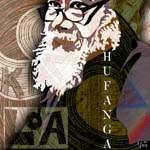 Professor Hūfanga-He-Ako-Moe-Lotu Dr ‘Ōkusitino Māhina is Professor of Tongan Philosophy, Historical Anthropology, and Aesthetics, Vava‘u Academy for Critical Inquiry and Applied Research, Vava‘u Tonga, and Tāmaki Makaurau Auckland, Aotearoa New Zealand. A leading tāvāist philosopher, actively yet critically engaged in the development and refinement of Tāvāism, he has published extensively, including books, co-authored books, co-edited books, co-edited journals, and a long list of book chapters and journal articles, as well as a book of Tongan poetry, with some translated into English and Te Reo Māori.
Professor Hūfanga-He-Ako-Moe-Lotu Dr ‘Ōkusitino Māhina is Professor of Tongan Philosophy, Historical Anthropology, and Aesthetics, Vava‘u Academy for Critical Inquiry and Applied Research, Vava‘u Tonga, and Tāmaki Makaurau Auckland, Aotearoa New Zealand. A leading tāvāist philosopher, actively yet critically engaged in the development and refinement of Tāvāism, he has published extensively, including books, co-authored books, co-edited books, co-edited journals, and a long list of book chapters and journal articles, as well as a book of Tongan poetry, with some translated into English and Te Reo Māori.
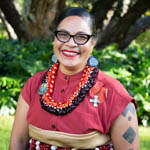 Kolokesa Uafā Māhina-Tuai, MNZM is Co-Founder-Director of Lagi-Maama Academy and Consultancy with Toluma‘anave Barbara Makuati-Afitu, based in Tāmaki Makaurau Auckland, Aotearoa New Zealand. She is a Senior Fellow at Vava‘u Academy for Critical Inquiry and Applied Research, Vava‘u Tonga, and Tāmaki Makaurau Auckland, Aotearoa New Zealand. She has published extensively, including co-authored books, co-edited books, co-edited journals and a long list of book chapters and journal articles especially within and across the cultural and heritage areas and informed by the Tā-Vā Time-Space Philosophy of Reality.
Kolokesa Uafā Māhina-Tuai, MNZM is Co-Founder-Director of Lagi-Maama Academy and Consultancy with Toluma‘anave Barbara Makuati-Afitu, based in Tāmaki Makaurau Auckland, Aotearoa New Zealand. She is a Senior Fellow at Vava‘u Academy for Critical Inquiry and Applied Research, Vava‘u Tonga, and Tāmaki Makaurau Auckland, Aotearoa New Zealand. She has published extensively, including co-authored books, co-edited books, co-edited journals and a long list of book chapters and journal articles especially within and across the cultural and heritage areas and informed by the Tā-Vā Time-Space Philosophy of Reality.
 Tavakefai‘ana, Sēmisi Fetokai Kulīha‘apai Moahehengiovava‘ulahi Potauaine lectures in Architecture, School of Art and Design at Unitec Institute of Technology, Tāmaki Makaurau Auckland, Aotearoa New Zealand, and a Senior Fellow at Vava‘u Academy for Critical Inquiry and Applied Research, Vava‘u Tonga, and Tāmaki Makaurau Auckland, Aotearoa New Zealand. Besides being a multimedia artist, a poet and dancer, sculptor and architect, he has co-authored books, co-edited books and a long list of both single-authored and co-authored book chapters and journal articles, deeply embedded in Tāvāism as a philosophy of reality.
Tavakefai‘ana, Sēmisi Fetokai Kulīha‘apai Moahehengiovava‘ulahi Potauaine lectures in Architecture, School of Art and Design at Unitec Institute of Technology, Tāmaki Makaurau Auckland, Aotearoa New Zealand, and a Senior Fellow at Vava‘u Academy for Critical Inquiry and Applied Research, Vava‘u Tonga, and Tāmaki Makaurau Auckland, Aotearoa New Zealand. Besides being a multimedia artist, a poet and dancer, sculptor and architect, he has co-authored books, co-edited books and a long list of both single-authored and co-authored book chapters and journal articles, deeply embedded in Tāvāism as a philosophy of reality.

